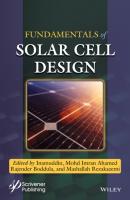Fundamentals of Solar Cell Design. Rajender Boddula
Чтение книги онлайн.

Читать онлайн книгу Fundamentals of Solar Cell Design - Rajender Boddula страница 27
Название: Fundamentals of Solar Cell Design
Автор: Rajender Boddula
Издательство: John Wiley & Sons Limited
Жанр: Физика
isbn: 9781119725046
isbn:
2.4 Advancements in Plasmonic Solar Cells
Nanotechnology has huge impact on producing efficient energy conversion devices due to its ability to develop novel materials. There are many experimental reports that confirm the enhancement in light absorption and efficiency because of light scattering from metal nanoparticles in plasmonic solar cells. The plasmonic nanostructures utilize the incident photons with multiple energy values and decrease the loss of photon energies. Researchers are finding the best way to use maximum incident photons for more absorption and high efficiency. The plasmonic solar cells are classified mainly into two categories as direct plasmonic and plasmonicenhanced solar PV cells [44, 45]. The schematic representation of various plasmonic solar cells is shown in Figures 2.6a (direct plasmonic solar cell) and 2.6b and 2.6c (plasmonic-enhanced solar cells). The efficiency for various plasmonic solar cell technologies is given in Figure 2.7. The various plasmonic solar cells and its efficiencies are summarized in Table 2.3.
Figure 2.5 Bandgap energy vs. λmax curve for various material used in solar cells. The values of this curve that are mentioned correspond to Table 2.2.
2.4.1 Direct Plasmonic Solar Cells
The direct plasmonic solar cells utilize plasmonic nanoparticles as active light absorbers. The hot charge carriers in plasmonic nanoparticles can be produced by excitation of SPR. The hot electrons can be introduced into semiconductor for converting sunlight into electric energy and hot holes can also be injected into a p-type semiconductor. The separation of charge carriers makes possible to use plasmonic nanostructures directly as photo absorbers. The metallic nanoparticles such as Au and Ag offers plasmonic band in visible range that can act as light harvesting antenna. Yocefu Hattori and Jacinto Sa have demonstrated direct plasmonic solar cell using gold surface plasmons [46]. Peafowl solar power company, a spinout company from Uppsala University, Sweden, has started to develop direct plasmonic transparent solar cells for commercial applications. The device configuration of this plasmonic solar cell is similar to traditional thin film PV cell. These plasmonic solar cells were manufactured inexpensively through a printing process at room temperature which can convert the light into electricity under very low light [47–49].
Figure 2.6 The device configuration of (a) direct and (b) plasmonic enhanced plasmonic solar cell and (c) plasmonic DSSC.
Figure 2.7 Efficiency for various plasmonic solar cell technology.
Table 2.3 Effect of various plasmonic nanostructures on solar cell technologies.
| Solar cell technology | Plasmonic nanostructure | Mechanism | Efficiency (%) | Reference |
| Hot carrier cell | Au@TiO2/PEDOT | Direct plasmonic transparent active layer | 0.2 | [46] 2019 |
| Au | Direct plasmonic as active layer | 24 | [59] Wu, 2013 | |
| Silicon | Ag with diameter 14-100 nm | At top surface | 26 | [27] Atwater HA, 2010 et al., 2010 |
| Al | At top of surface | 14.5 | [53] 2013 | |
| Au | At top of surface | 14 | [115] Jacak, 2018 | |
| Ag | At top of surface | 12.8 | [115] Jacak, 2018 | |
| GaAs | Ag | At top of surface | 22.15 | [94] 2019 |
| Ag | At top surface | 5.9 | [51] 2008 | |
| CIGS | Au | At top surface | 4 | [61] Londhe, 2016 |
| Ag | At top surface | 9.44 | [115] Jacak, 2018 | |
| Au | At top surface | 10.34 | [115] Jacak, 2018 | |
| CdTe | Au | At top surface | 9 | [62] Kim, 2015 |
| CZTS | Au | At back surface | 9 |
СКАЧАТЬ
|